+ Open data
Open data
- Basic information
Basic information
| Entry | Database: PDB / ID: 5khe | ||||||
|---|---|---|---|---|---|---|---|
| Title | Fitted structure of rubella virus capsid protein | ||||||
 Components Components | capsid protein | ||||||
 Keywords Keywords | VIRAL PROTEIN / rubella virus capsid protein | ||||||
| Function / homology |  Function and homology information Function and homology informationT=4 icosahedral viral capsid / host cell Golgi membrane / host cell mitochondrion / viral nucleocapsid / clathrin-dependent endocytosis of virus by host cell / fusion of virus membrane with host endosome membrane / viral envelope / virion attachment to host cell / virion membrane / RNA binding ...T=4 icosahedral viral capsid / host cell Golgi membrane / host cell mitochondrion / viral nucleocapsid / clathrin-dependent endocytosis of virus by host cell / fusion of virus membrane with host endosome membrane / viral envelope / virion attachment to host cell / virion membrane / RNA binding / metal ion binding / membrane Similarity search - Function | ||||||
| Biological species |  Rubella virus Rubella virus | ||||||
| Method | ELECTRON MICROSCOPY / subtomogram averaging / cryo EM / Resolution: 35 Å | ||||||
 Authors Authors | Mangala Prasad, V. / Klose, T. / Rossmann, M.G. | ||||||
| Funding support |  United States, 1items United States, 1items
| ||||||
 Citation Citation |  Journal: PLoS Pathog / Year: 2017 Journal: PLoS Pathog / Year: 2017Title: Assembly, maturation and three-dimensional helical structure of the teratogenic rubella virus. Authors: Vidya Mangala Prasad / Thomas Klose / Michael G Rossmann /  Abstract: Viral infections during pregnancy are a significant cause of infant morbidity and mortality. Of these, rubella virus infection is a well-substantiated example that leads to miscarriages or severe ...Viral infections during pregnancy are a significant cause of infant morbidity and mortality. Of these, rubella virus infection is a well-substantiated example that leads to miscarriages or severe fetal defects. However, structural information about the rubella virus has been lacking due to the pleomorphic nature of the virions. Here we report a helical structure of rubella virions using cryo-electron tomography. Sub-tomogram averaging of the surface spikes established the relative positions of the viral glycoproteins, which differed from the earlier icosahedral models of the virus. Tomographic analyses of in vitro assembled nucleocapsids and virions provide a template for viral assembly. Comparisons of immature and mature virions show large rearrangements in the glycoproteins that may be essential for forming the infectious virions. These results present the first known example of a helical membrane-enveloped virus, while also providing a structural basis for its assembly and maturation pathway. | ||||||
| History |
|
- Structure visualization
Structure visualization
| Movie |
 Movie viewer Movie viewer |
|---|---|
| Structure viewer | Molecule:  Molmil Molmil Jmol/JSmol Jmol/JSmol |
- Downloads & links
Downloads & links
- Download
Download
| PDBx/mmCIF format |  5khe.cif.gz 5khe.cif.gz | 57.9 KB | Display |  PDBx/mmCIF format PDBx/mmCIF format |
|---|---|---|---|---|
| PDB format |  pdb5khe.ent.gz pdb5khe.ent.gz | 37.5 KB | Display |  PDB format PDB format |
| PDBx/mmJSON format |  5khe.json.gz 5khe.json.gz | Tree view |  PDBx/mmJSON format PDBx/mmJSON format | |
| Others |  Other downloads Other downloads |
-Validation report
| Summary document |  5khe_validation.pdf.gz 5khe_validation.pdf.gz | 655.7 KB | Display |  wwPDB validaton report wwPDB validaton report |
|---|---|---|---|---|
| Full document |  5khe_full_validation.pdf.gz 5khe_full_validation.pdf.gz | 656.3 KB | Display | |
| Data in XML |  5khe_validation.xml.gz 5khe_validation.xml.gz | 11.2 KB | Display | |
| Data in CIF |  5khe_validation.cif.gz 5khe_validation.cif.gz | 15.9 KB | Display | |
| Arichive directory |  https://data.pdbj.org/pub/pdb/validation_reports/kh/5khe https://data.pdbj.org/pub/pdb/validation_reports/kh/5khe ftp://data.pdbj.org/pub/pdb/validation_reports/kh/5khe ftp://data.pdbj.org/pub/pdb/validation_reports/kh/5khe | HTTPS FTP |
-Related structure data
| Related structure data |  8249MC  8248C  8250C  8251C  5khcC  5khfC M: map data used to model this data C: citing same article ( |
|---|---|
| Similar structure data |
- Links
Links
- Assembly
Assembly
| Deposited unit | 
|
|---|---|
| 1 |
|
- Components
Components
| #1: Protein | Mass: 30016.332 Da / Num. of mol.: 2 / Fragment: UNP residues 9-277 Source method: isolated from a genetically manipulated source Source: (gene. exp.)  Rubella virus / Production host: Rubella virus / Production host:  #2: Water | ChemComp-HOH / | Has protein modification | Y | |
|---|
-Experimental details
-Experiment
| Experiment | Method: ELECTRON MICROSCOPY |
|---|---|
| EM experiment | Aggregation state: PARTICLE / 3D reconstruction method: subtomogram averaging |
- Sample preparation
Sample preparation
| Component | Name: Rubella virus strain M33 / Type: COMPLEX / Entity ID: #1 / Source: RECOMBINANT | |||||||||||||||
|---|---|---|---|---|---|---|---|---|---|---|---|---|---|---|---|---|
| Molecular weight | Value: 0.064 MDa / Experimental value: NO | |||||||||||||||
| Source (natural) | Organism:  Rubella virus strain M33 Rubella virus strain M33 | |||||||||||||||
| Source (recombinant) | Organism:  | |||||||||||||||
| Buffer solution | pH: 7.2 | |||||||||||||||
| Buffer component |
| |||||||||||||||
| Specimen | Conc.: 1 mg/ml / Embedding applied: NO / Shadowing applied: NO / Staining applied: NO / Vitrification applied: YES | |||||||||||||||
| Specimen support | Grid material: COPPER / Grid mesh size: 200 divisions/in. / Grid type: Quantifoil R1.2/1.3 | |||||||||||||||
| Vitrification | Instrument: GATAN CRYOPLUNGE 3 / Cryogen name: ETHANE |
- Electron microscopy imaging
Electron microscopy imaging
| Experimental equipment |  Model: Titan Krios / Image courtesy: FEI Company |
|---|---|
| Microscopy | Model: FEI TITAN KRIOS |
| Electron gun | Electron source:  FIELD EMISSION GUN / Accelerating voltage: 300 kV / Illumination mode: SPOT SCAN FIELD EMISSION GUN / Accelerating voltage: 300 kV / Illumination mode: SPOT SCAN |
| Electron lens | Mode: BRIGHT FIELD / Nominal magnification: 11000 X / Nominal defocus min: 500 nm |
| Image recording | Electron dose: 1 e/Å2 / Detector mode: SUPER-RESOLUTION / Film or detector model: GATAN K2 SUMMIT (4k x 4k) |
- Processing
Processing
| EM software |
| ||||||||||||||||||||||||
|---|---|---|---|---|---|---|---|---|---|---|---|---|---|---|---|---|---|---|---|---|---|---|---|---|---|
| CTF correction | Type: PHASE FLIPPING AND AMPLITUDE CORRECTION | ||||||||||||||||||||||||
| Symmetry | Point symmetry: C1 (asymmetric) | ||||||||||||||||||||||||
| 3D reconstruction | Resolution: 35 Å / Resolution method: OTHER / Num. of particles: 18 / Symmetry type: POINT | ||||||||||||||||||||||||
| EM volume selection | Method: manual picking / Num. of tomograms: 15 / Num. of volumes extracted: 20 / Reference model: none | ||||||||||||||||||||||||
| Atomic model building | Protocol: RIGID BODY FIT / Space: REAL / Target criteria: sumf |
 Movie
Movie Controller
Controller





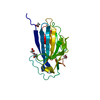

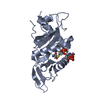

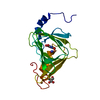
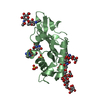
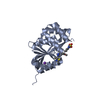

 PDBj
PDBj

